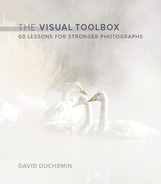Lesson 18. Explore Color Contrast
While we’re on the subject of intentional use of color, consider the role of contrasting colors in your compositions. Contrasting colors—at least the way I will refer to them—are not colors that clash and work against each other, but colors that are considered complementary. When you look at the color wheel, it’s the colors lying across from each other that are considered complementary, and it’s there you’ll find ideas about using color contrast. But why consider this at all?
Stronger color contrast introduces stronger visual mass to the contrasting element, pulling the eye with greater strength. It can also give the image a greater sense of depth, because color contrast creates separation—the principle, in general terms, is that brighter/warmer colors leap forward whereas cooler colors fall back. The brighter and more saturated these colors, the greater the contrast and depth. This addition of depth will be experienced differently than a flatter image that, by virtue of its more uniform color palette, might seem more serene. Again, as with so many of these visual tools, it’s not a matter of one tool being better than another; it’s a matter of one tool creating a different aesthetic and giving us the choice between those aesthetics as we look to create photographs that express certain things, or create certain experiences.
There’s another effect of using complementary colors we need to be aware of—the presence of other colors affects the way we see a color. In the case of complementary colors, the presence of one will make the other appear more intense. Not unlike using scale—when we put something large in the presence of something small, the larger thing appears, by contrast, even larger. Green will look green enough, but put something magenta into the scene and the green will look even greener. Just one more tool to be aware of. Every effect can be useful if we’re aware of it.

Nikon D3s, 24mm, 1 second @ f/4.5, ISO 200
Two nearly identical images, but adding the light from a warm-gelled flashlight increased the color contrast and the depth in the second. Look at the color wheel and you’ll notice that immediately opposite from the blue of the scene is the warm yellow of the rock.
Canon EOS 20D, 29mm, 1/125 @ f/4.0, ISO 800
Keeping your eye open for color combinations that make use of contrasting colors might be no harder than just knowing what your eye is already drawn to. I don’t need to know my color-wheel to know that these blue phones pop out against this pink wall in Harar, Ethiopia, and draw more attention to both the phones and the wall.

